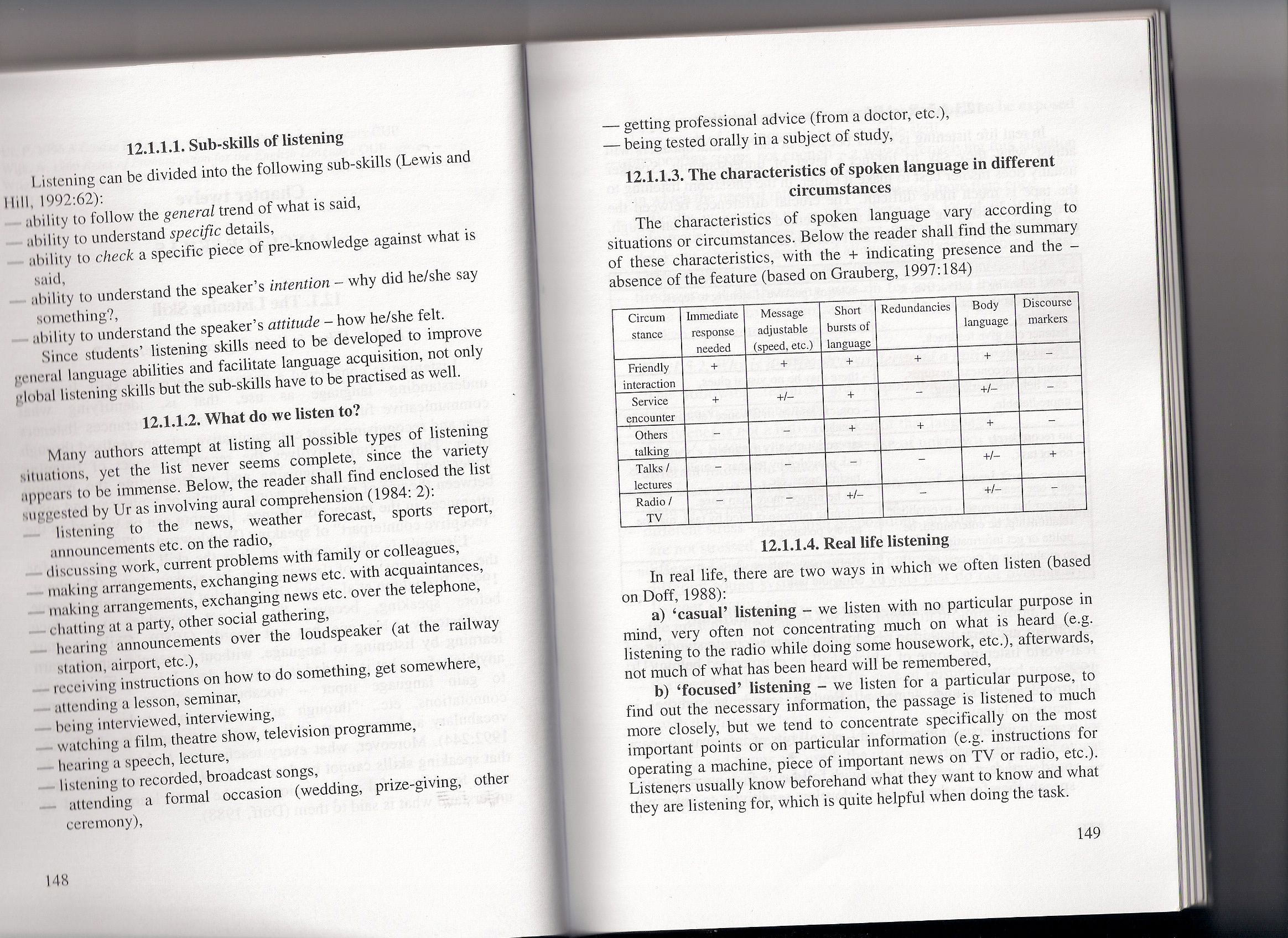47005 skanowanie0074 (3)

12.1.1.1. Sub-skills of listening
Listening can be divided into the foliowing sub-skills (Lewis and Hilli 1992:62):
— ubility to follow the generał trend of what is said,
— ability to understand specific details,
— ability to check a specific piece of pre-knowledge against what is said,
— ability to understand the speaker’s intention - why did he/she say something?,
— ability to understand the speaker’s attitude - how he/she felt.
Since students’ listening skills need to be developed to improve generał language abilities and facilitate language acąuisition, not only global listening skills but the sub-skills have to be practised as well.
12.1.1.2. What do we listen to?
Many authors attempt at listing all possible types of listening siluations, yet the list never seems complete, sińce the variety appears to be immense. Below, the reader shall find enclosed the list suggested by Ur as involving aural comprehension (1984: 2):
listening to the news, weather forecast, sports report, announcements etc. on the radio,
discussing work, current problems with family or colleagues,
— making arrangements, exchanging news etc. with acąuaintances,
— making arrangements, exchanging news etc. over the telephone,
— chatting at a party, other social gathering,
— hearing announcements over the loudspeaker (at the railway station, airport, etc.),
— receiving instructions on how to do something, get somewhere,
— iittending a lesson, seminar,
— being interviewed, interviewing,
— watching a film, theatre show, television programme,
— hearing a speech, lecture,
— listening to recorded, broadcast songs,
- attending a formal occasion (wedding, prize-giving, other ceremony),
— getting professional advice (from a doctor, etc.), being tested orally in a subject of study,
12.1.1.3. The characteristics of spoken language in different circumstances
The characteristics of spoken language vary according to situations or circumstances. Below the reader shall find the summary of these characteristics, with the + indicating presence and the -absence of the feature (based on Grauberg, 1997:184)
|
Circum stance |
Immediate response needed |
Message adjustable (speed, etc.) |
Short bursts of language |
Redundancies |
Body language |
Discóurse markers |
|
Friendly interaction |
;■ ,-fH A |
nkuH |
+ |
+ |
- | |
|
Service ęncounter |
+ |
+/- |
+ |
- |
+/- |
- |
|
Others talking |
- |
- |
+ |
+ |
+ |
- |
|
Talks / lectures |
- |
- |
- |
- |
+/- | |
|
Radio / TV |
- |
- |
+/- |
- |
+/- |
- |
12.1.1.4. Real life listening
In real life, there are two ways in which we often listen (based on Doff, 1988):
a) ‘casuaP listening - we listen with no particular purpose in mind, very often not concentrating much on what is heard (e.g. listening to the radio while doing some housework, etc.), afterwards, not much of what has been heard will be remembered,
b) ‘focused’ listening - we listen for a particular purpose, to find out the necessary information, the passage is listened to much morę closely, but we tend to concentrate specifically on the most important points or on particular information (e.g. instructions for operating a machinę, piece of important news on TV or radio, etc.). Listeners usually know beforehand what they want to know and what they are listening for, which is quite helpful when doing the task.
149
Wyszukiwarka
Podobne podstrony:
47005 skanowanie0074 (3) 12.1.1.1. Sub-skills of listening Listening can be divide
skanowanie0074 (3) 12.1.1.1. Sub-skills of listening Listening can be divided into
The division of sentences Sentences can be divided on the basis of: - Their functi
GSM Architecture The functions of the NMS can be divided into three categories: •
1.2. Goal and Plan of the Work 3 It is assumed that the goal of this work can be reached in the foll
image016 reached Romę. Perhaps the last tracę of Sventovit’s treasure can be found in the testa
III. MODEL FORMULATION The output voltage of a single celi can be defined as the result of the follo
skanowanie0076 (3) 12.1.1.5.3. What makes classroom listening difficult? There are some factors whic
skanowanie0076 (3) 12.1.1.5.3. What makes classroom listening difficult? There are some factors whic
skanowanie0035 (12) Criteria levels of performance The reąuired level of performance for success sho
skanowanie0042 (10) the preparation of lesson plans can be very helpful. Especially, if this knowled
00027 ?6ad09812700ed54e35de4f20e2a7ad 26 Molnau The SPR procedurę can be applied to the fuli rangę
00102 B2805d720a3f852501694e34fead415 101 The OCAP seldom-used terminators can be moved to the end
więcej podobnych podstron